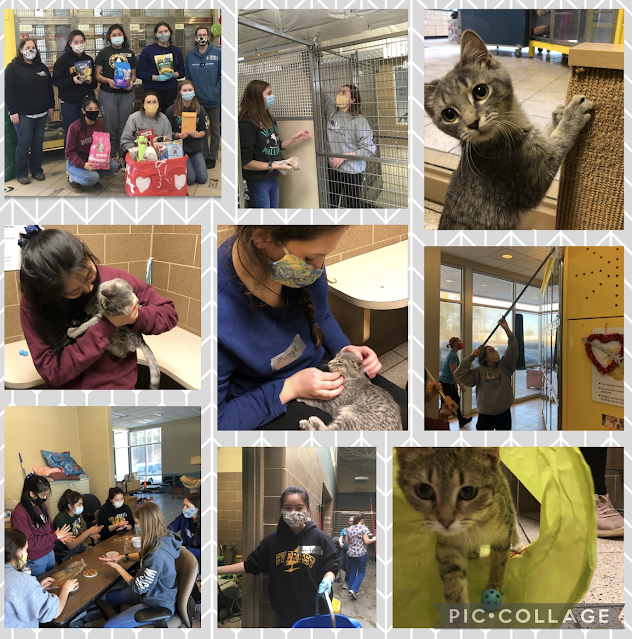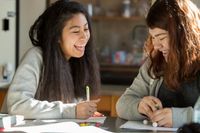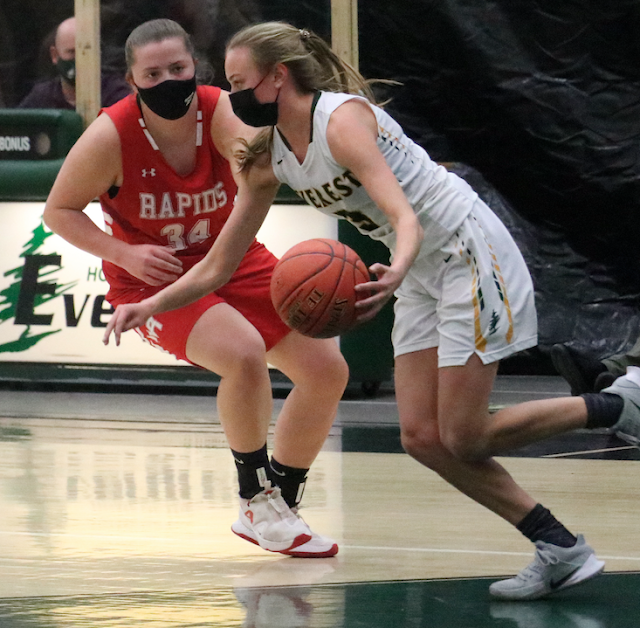D.C. Everest Senior High School Staff Update
Weekly Happenings
Let's start with the Art show everyone saw on Thursday. If you haven't - THIS IS AMAZING! Great work Melissa! Appreciate the Jazz band as well Joe! Consistently amazed by the talented students who walk our halls and our faculty and staff who are able to get the most out of them!
A very nice story on WSAW this week. Great job to Jeremy Brandt, Tiphany Schmidt, and all the team members to get the coffee shop, and an authentic work experience, up and running this year! Link to story here
Key Club brought in over $450 in their second volunteering stint at the Humane Society. Check out the Pic Collage below. Thank you to Julie Rice and Megan Ackley for your leadership with Key Club!
Great work this season by the DC Everest Fishing Club! Big thank you to Joel Deboer, Pete Thorpe, Liz Mammano, and their team for their efforts. Check out the pic collage below.
Thanks to Mark Schommer for sharing the following tweet with me - Powerful words!
Interesting Information
Getting Started With Culturally Responsive Teaching
Understanding students’ lives can help teachers foster a sense of belonging and ensure that all students feel respected and challenged.
By Nikki Williams Rucker
The world of education is buzzing with talk of being more culturally responsive, but what does that mean, and how important is it really?
When I talk about culture, I’m talking about norms, beliefs, and behaviors that are passed down from one generation to the next—the things that explain why a student might answer a question the way he does or why another might not feel comfortable looking you in the eye when you’re speaking to her. These aspects of culture are among the most misunderstood in the teacher-student dynamic and are often the things that cause students to get into the most trouble in the school discipline system. Culturally responsive teaching (CRT) attempts to bridge the gap between teacher and student by helping the teacher understand the cultural nuances that may cause a relationship to break down—which ultimately causes student achievement to break down as well.
In her book Culturally Responsive Teaching and the Brain, Zaretta Hammond writes that “by third grade, many culturally and linguistically diverse students are one or more years behind in reading.” CRT is one of the most impactful tools for empowering students to find their way out of that achievement gap. This alone makes being culturally responsive one of the most important things you can learn at this moment.
GETTING STARTED
The first step in being culturally responsive is to do an internal audit—yes, you read that right, an audit: truly digging deep inside of ourselves and recognizing and naming those things we don’t want to look at or talk about. The experiences we’ve had along our journey in life have formed stereotypes which have then turned into implicit bias. These unintentional, unconscious attitudes impact how we relate to our students and their parents, and how we choose curriculum, assess learning, and plan lessons. Harvard University’s Project Implicit has an online test you can take to examine your implicit bias.
Culturally responsive teachers also have to be aware of the sociopolitical context schools operate in and dare to go against that status quo. Students need to understand the system that is working around them in schools. Give them context and don’t be afraid to talk about the tough subjects that may not be addressed in your school. In addition to Hammond’s Culturally Responsive Teaching and the Brain, another great resource is Affirming Diversity by Sonia Nieto. The most important part of this work is a willingness to do something different to get different results, with the goal of increasing academic achievement.
For your audit, take some time to ask yourself hard questions and reflect on past and current practices. Are you operating from a place of critical care within your classroom—a place that marries high expectations with empathy and compassion? Are your students, regardless of socioeconomic status or background, being held to high standards? Has your past interaction with a particular race of people impacted your ability to communicate with parents? Identify those places in your instructional planning where you might have allowed your implicit biases to prevent you from pushing your students to achieve at optimal levels. Answering questions like these might be hard, but in order to create change, you have to identify and unearth the roots of your teaching practice.
NEXT STEPS
Now that you have conducted an internal self-audit, your curriculum will need one as well. What books are students reading? Do they have a voice in what they read, where they sit, how they interact with each other?
Empowering students to take ownership of not just their learning but the environment itself is another critical component of CRT. One strategy for fostering a student-centered environment is having students create a classroom agreement that answers the question: “How will we be together?” Allowing students to answer this question will give you a window into how their cultures dictate the ways in which they want to feel respected, heard, safe, and included in the classroom and in their interactions with one another and with you. This reinforces the idea not only that they belong but that the way they show up at school every day, with all of their outside experiences in tow, has value.
Finally, put some thought into your lesson planning. You have taken the time to reflect and really look into your own biases that may have been getting in your way. You have revamped your classroom environment to reflect your students’ voices, their various cultural needs, and their choice. Now let’s have some fun.
- Encourage students to make a social media campaign that champions their favorite cause, and have them bring evidence of their results to class to discuss the role social media plays in social change.
- Use current songs that students might love to analyze the use of literary techniques and imagery in music videos. Taylor Swift’s “Wildest Dreams” is a great one. Better yet, instead of assigning a song, ask students for their suggestions.
- Watch and discuss documentaries like Race: The Power of an Illusion.
- Zaretta Hammond shared three simple strategies you can use to make lessons in any subject more culturally responsive.
Being culturally responsive encourages students to feel a sense of belonging and helps create a safe space where they feel safe, respected, heard, and challenged.
Announcements/Week Ahead
A note from Sunshine - A congratulations card and a Target gift card were shared with Brandon Stremkowski and his wife on the finalization of their two adopted children. We’re excited to see their family grow!
AP Review Date - Aspire testing is scheduled for April 28. Typically on this date, we have allowed AP teachers to bring in their students for reviews. Unfortunately, due to social distancing requirements, we are going to need our whole staff to proctor this test. We will not be having the 28th as an AP review day. I would encourage AP teachers to use Flexible Fridays for this practice.
Parent-Teacher Contact Time - A reminder that there are an additional 3 hours built-in for teachers to connect with parents. This can be done by email, phone, WebEx, etc. We choose not to schedule these three hours to increase flexibility for both faculty and parents.
Important Dates:
March:
Three additional hours of flexible Parent-Teacher conferences by March 10


























